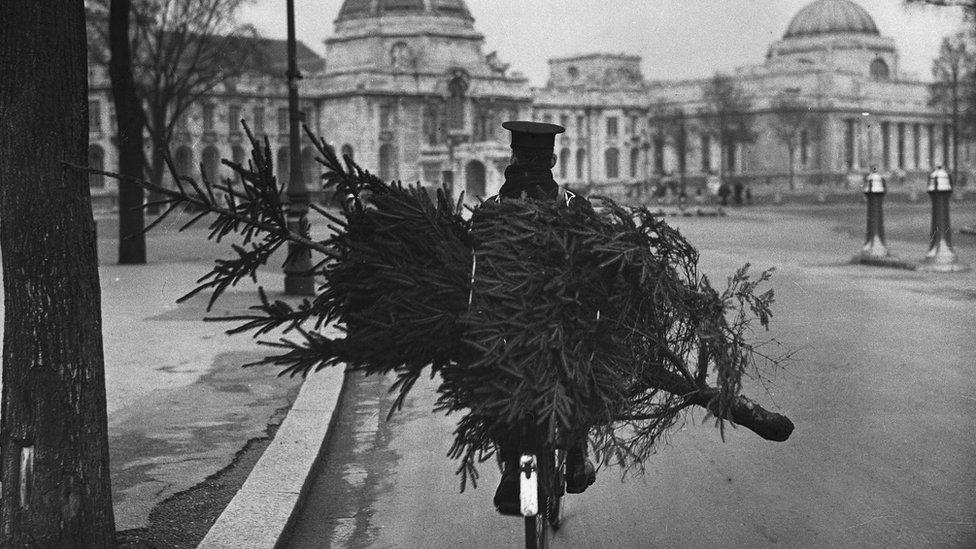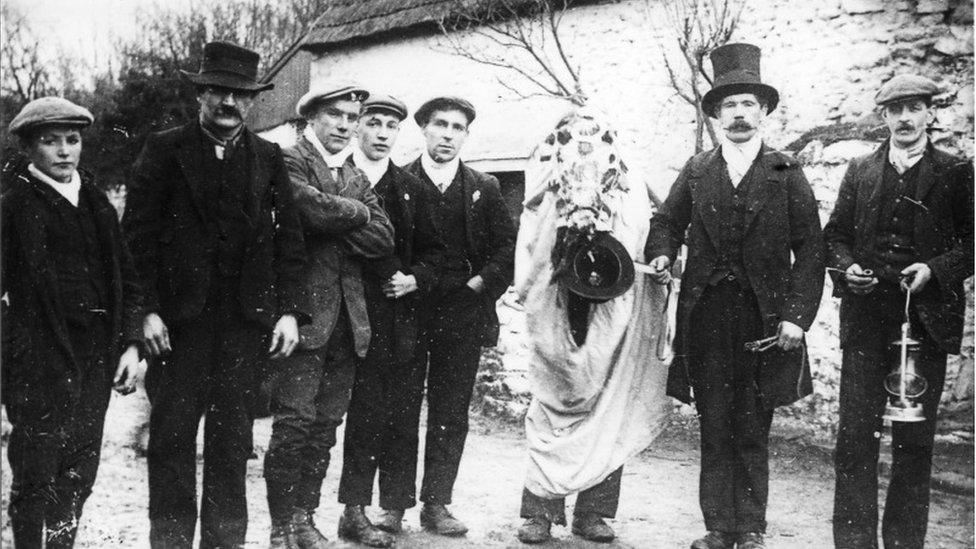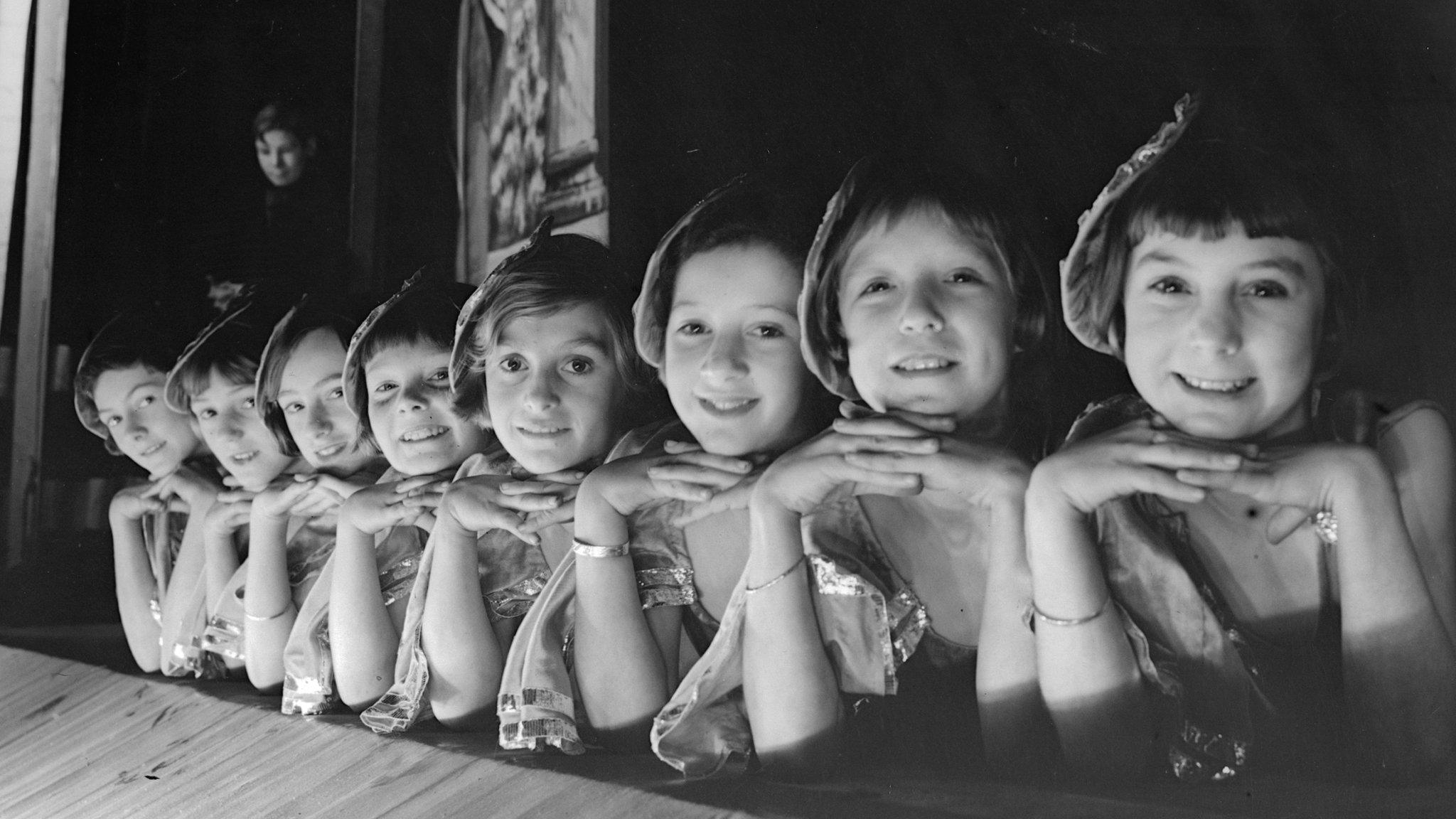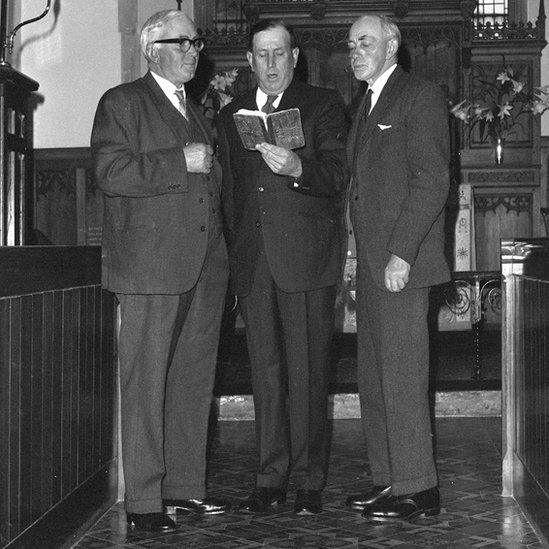How Santa Claus replaced Wales' traditional Christmas
- Published

A Cardiff postman cycles home with a Christmas tree on the back of his bicycle in 1939
As Wales celebrates Christmas, historian Martin Johnes says that while the country's celebrations are no different to anywhere else in the western world, it was not always that way.
In 1919, the Welsh-language newspaper Y Cymro urged readers not to reject Father Christmas because he had an English name.
In fact, the modern stocking-filling Santa Claus was an import to England from the USA, external.
By World War One, he had already made his way to homes, parties and stores across Wales, where he was another symbol of the increasingly uniform Christmas culture created by the Victorians.
Traditional customs
Before this culture emerged in the mid-19th Century, Christmas in Wales had been a mixed bag of local customs. In some villages, it took second place to New Year but elsewhere there were carnival-esque rituals for people to enjoy.
These varied from place to place but all were important parts of local communities' identities. They helped define what it meant to be from somewhere, even if identical customs could be found in other communities.
The customs included visits to the neighbours, sometimes accompanied by singing and in costume, football matches, torch-lit processions, the burning of Yule logs, the making of toffee and even the hunting of wrens, rabbits or squirrels.

The Mari Lwyd in Llangynwyd c1919
These customs nearly all shared one common characteristic - they were communal events that not only entertained but also reinforced neighbourly ties.
Nor were they unique to Wales. Instead, they were part of a rural culture that existed across the British Isles. Even a version of the Mari Lwyd, external, the best known of these customs, which involved singers going from house to house, reciting rhymes and carrying a horse's skull could be found in Kent.
If there was one tradition that was unique to Wales, it was the plygain, external. This was a form of Welsh-language carol service that took place very early on Christmas morning, with the congregation leaving at dawn and often going on to celebrate in a less sacred fashion.
Like all local Christmas traditions, plygain had faded significantly by the early 20th Century. This was because of their associations with drink and rowdyism and the disruption to community life brought about by 19th Century industrialisation and the associated movements of people.
But the decline of local customs was also a product of the Victorian emergence of a national British festive culture based around bought presents, trees, cards, Santa Claus and dinner.
These new traditions were promoted by commercial forces and were charming and appealing. With the Christian church not challenging the developments, there was little to stop their advance and the popular idea of how to celebrate Christmas changed.
Rather than being seen as a marker of local identity, the festival was increasingly instead celebrated as a symbol of Britishness.

A row of children performing in a Christmas pantomime at Cardiff in 1934
Over the course of the 20th Century, improving living standards, radio, television, royal speeches and pantomime all furthered the idea that the British people were celebrating Christmas in the same way and that the differences of class, nation and region were fading.
Change was slower in Scotland but even there the growing celebration of Christmas in the first half of the 20th Century was used as a marker of the Anglicisation of Scottish culture.
Folk revivals
In Wales, this British popular culture was thought to be undermining the Welsh language and its associated culture. In England too, concerns grew about the fate of traditional customs in the face of the forces of modernisation.
First, between the wars, and then more often in the 1950s and 1960s, there were conscious efforts across Britain to preserve or revive the last remnants of traditional festive customs.
Television, one of the final culprits in their decline, played a part in the attempted revival by filming people practising the Mari Lwyd and other customs.

Plygain singers
Like the establishment of a folk museum at St Fagans, this was all intended to preserve a specifically Welsh culture but it was also promoted as a marker of local community spirit and tradition.
These two perspectives went hand in hand. Welsh culture had always been a localised phenomenon. When people thought of Wales, they tended to imagine their bit of it rather than the nation as a whole.
That meant cultural similarities with other areas, in and outside Wales, were often overlooked.
A global festival
No matter how strong Welsh identity is, there is little about its culture, beyond the Welsh language, that is unique.
Those who claimed Christmas as a British festival were also overstepping the point, not least because of Christianity's global importance and because Christmas trees originated in Germany and the modern Santa came from the USA.

Home covered with Christmas decorations in Mold, Flintshire
American films also encouraged the emergence of a festival with strong common characteristics across the western world. Extravagant lights on the outside of homes were an obvious example but even holly wreaths on doors were an imitation of an American tradition.
But even if the festival in Wales carries the marks of both Britishness and Americanisation, its importance is not what it says about nationhood.
For the vast majority of the Welsh, Christmas was and is a festival of shopping, family and fun. For a smaller number, it is also a religious festival. For a minority, it is a time of annoyance and even sadness.
Wales is no different in any of this to anywhere in the western world. Indeed, this is in line with what many people have always imagined Christmas is all about: a time of peace and goodwill for all, regardless of which country they come from.
Martin Johnes teaches history at Swansea University and is the author of a book, Christmas and the British: A Modern History.
This article was originally published on 25 December 2016.
- Published17 December 2018

- Published4 December 2018
